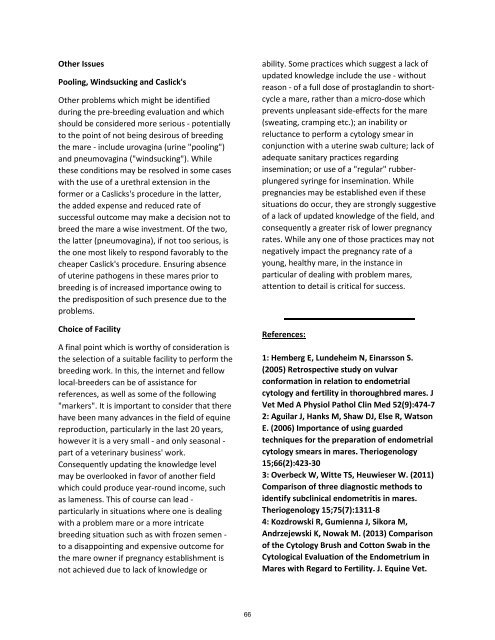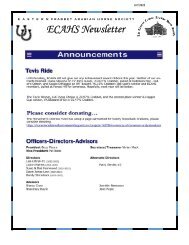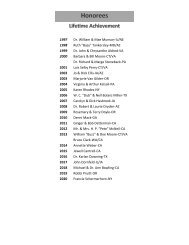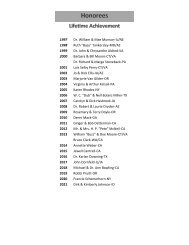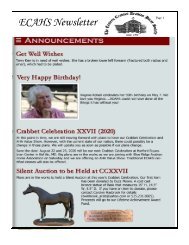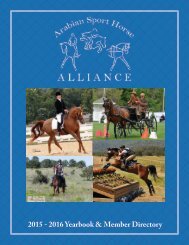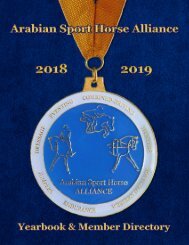Arabian Sport Horse Alliance 2017-2018 Directory & Yearbook
Annual publication of the Arabian Sport Horse Alliance, Inc. Honoree Articles, Award Listings, Photo Galleries, Youth Member Spotlights, Stallion Pages, Farm Profiles, Educational Articles, and more.....
Annual publication of the Arabian Sport Horse Alliance, Inc.
Honoree Articles, Award Listings, Photo Galleries, Youth Member Spotlights, Stallion Pages, Farm Profiles, Educational Articles, and more.....
You also want an ePaper? Increase the reach of your titles
YUMPU automatically turns print PDFs into web optimized ePapers that Google loves.
Other Issues<br />
Pooling, Windsucking and Caslick's<br />
Other problems which might be identified<br />
during the pre-breeding evaluation and which<br />
should be considered more serious - potentially<br />
to the point of not being desirous of breeding<br />
the mare - include urovagina (urine "pooling")<br />
and pneumovagina ("windsucking"). While<br />
these conditions may be resolved in some cases<br />
with the use of a urethral extension in the<br />
former or a Caslicks's procedure in the latter,<br />
the added expense and reduced rate of<br />
successful outcome may make a decision not to<br />
breed the mare a wise investment. Of the two,<br />
the latter (pneumovagina), if not too serious, is<br />
the one most likely to respond favorably to the<br />
cheaper Caslick's procedure. Ensuring absence<br />
of uterine pathogens in these mares prior to<br />
breeding is of increased importance owing to<br />
the predisposition of such presence due to the<br />
problems.<br />
Choice of Facility<br />
A final point which is worthy of consideration is<br />
the selection of a suitable facility to perform the<br />
breeding work. In this, the internet and fellow<br />
local-breeders can be of assistance for<br />
references, as well as some of the following<br />
"markers". It is important to consider that there<br />
have been many advances in the field of equine<br />
reproduction, particularly in the last 20 years,<br />
however it is a very small - and only seasonal -<br />
part of a veterinary business' work.<br />
Consequently updating the knowledge level<br />
may be overlooked in favor of another field<br />
which could produce year-round income, such<br />
as lameness. This of course can lead -<br />
particularly in situations where one is dealing<br />
with a problem mare or a more intricate<br />
breeding situation such as with frozen semen -<br />
to a disappointing and expensive outcome for<br />
the mare owner if pregnancy establishment is<br />
not achieved due to lack of knowledge or<br />
ability. Some practices which suggest a lack of<br />
updated knowledge include the use - without<br />
reason - of a full dose of prostaglandin to shortcycle<br />
a mare, rather than a micro-dose which<br />
prevents unpleasant side-effects for the mare<br />
(sweating, cramping etc.); an inability or<br />
reluctance to perform a cytology smear in<br />
conjunction with a uterine swab culture; lack of<br />
adequate sanitary practices regarding<br />
insemination; or use of a "regular" rubberplungered<br />
syringe for insemination. While<br />
pregnancies may be established even if these<br />
situations do occur, they are strongly suggestive<br />
of a lack of updated knowledge of the field, and<br />
consequently a greater risk of lower pregnancy<br />
rates. While any one of those practices may not<br />
negatively impact the pregnancy rate of a<br />
young, healthy mare, in the instance in<br />
particular of dealing with problem mares,<br />
attention to detail is critical for success.<br />
References:<br />
1: Hemberg E, Lundeheim N, Einarsson S.<br />
(2005) Retrospective study on vulvar<br />
conformation in relation to endometrial<br />
cytology and fertility in thoroughbred mares. J<br />
Vet Med A Physiol Pathol Clin Med 52(9):474-7<br />
2: Aguilar J, Hanks M, Shaw DJ, Else R, Watson<br />
E. (2006) Importance of using guarded<br />
techniques for the preparation of endometrial<br />
cytology smears in mares. Theriogenology<br />
15;66(2):423-30<br />
3: Overbeck W, Witte TS, Heuwieser W. (2011)<br />
Comparison of three diagnostic methods to<br />
identify subclinical endometritis in mares.<br />
Theriogenology 15;75(7):1311-8<br />
4: Kozdrowski R, Gumienna J, Sikora M,<br />
Andrzejewski K, Nowak M. (2013) Comparison<br />
of the Cytology Brush and Cotton Swab in the<br />
Cytological Evaluation of the Endometrium in<br />
Mares with Regard to Fertility. J. Equine Vet.<br />
66


